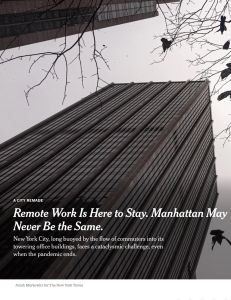Join getAbstract to access the summary!

Join getAbstract to access the summary!
Matthew Haag
Remote Work Is Here to Stay. Manhattan May Never Be the Same.
New York City, long buoyed by the flow of commuters into its towering office buildings, faces a cataclysmic challenge, even when the pandemic ends.
The New York Times, 2021
What's inside?
Remote working policies are here to stay. The New York Times’ Matthew Haag explores how this will affect people, companies and cities in the long term.
Recommendation
The coronavirus pandemic continues to shape how and where people work, Matthew Haag reports in The New York Times. Remote working, once an uncommon benefit, became the norm almost overnight as lockdowns gripped cities around the world. A year later, these policies are here to stay, as employers and employees recognize the benefits of flexible work. However, cities and businesses miss the income daily commuters generate, as distinctions between work and home life blur. These effects may linger long after the pandemic ends.
Summary
About the Author
The New York Times reporter Matthew Haag covers the intersection of real estate and politics in New York City.
















Comment on this summary